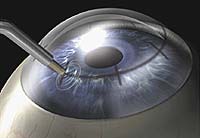Conductive keratoplasty offers hyperopes a non-laser alternative
One-year results suggest CK provides postoperative stability for hyperopes.
MIAMI — Preliminary clinical trials suggest that conductive keratoplasty (CK) using Refractec’s radio frequency method is probably safe and effective for correcting low to moderate amounts of hyperopia, according to Penny A. Asbell, MD, who presented clinical trial data, here, at the International Society of Refractive Surgery meeting. “Early results with our data out to 12 months suggest that we get great visual acuity, very good stability and really no adverse events such as loss of vision,” said Dr. Asbell.
CK heats the stromal tissue with an electric current, shrinks the collagen and steepens the central cornea, Dr. Asbell explained. A high-frequency current is applied directly into the peripheral corneal stroma through a delivery tip inserted at eight or more treatment points. The release of radio frequency energy heats the surrounding collagen to a homogenous temperature of 65°C and produces a cylindrical footprint 500 mm deep vs. a shallower, conical footprint made with the laser thermal keratoplasty (LTK) technique. A full circle of CK-treated spots cinches the cornea and increases its curvature to decrease hyperopia.
“The change seems to be permanent, and I think one of the reasons that’s true is that the treatment we do is delivered directly to the stroma,” said Dr. Asbell. “That’s where you want the effect — not on the endothelium, not on the epithelium. It’s a very easy surgical technique. It’s a non-laser technique, and it adds another dimension to what we already can offer for refractive surgery — it is a cost-effective procedure,” she added.
CK is consistent
 ---Central corneal
steepening as a result of CK treatment application is shown.
---Central corneal
steepening as a result of CK treatment application is shown.
Another key issue, Dr. Asbell pointed out, is that CK is a consistent
treatment. “The treatment size and the zone effect in the stroma are
consistent from treatment spot to treatment spot,” she said. “One of
the key issues to remember is that the temperature that we get with the CK
procedure is always 65°, and the imprint that you make within the
peripheral corneal stroma is always the same: 100 µm wide and 500
µm deep within the corneal stroma.”
Dr. Asbell is an investigator in the Food and Drug Administration clinical trial of CK. Fellow investigators at other sites include Marguerite McDonald, MD; Robert K. Maloney, MD; Jonathan Davidorf, MD; Peter Hersh, MD; and Edward E. Manche, MD.
Of the 54 patients on whom Dr. Asbell reported, the typical age was 55, although, she said, there is a fairly big range of age among the trial’s participants. To qualify for the trial, she explained, patients had to have uncorrected visual acuity of at least 20/40 or worse and poor near vision as well — standard for a hyperope. “We are correcting from 1 D to 4 D of hyperopia, with little or no astigmatism,” Dr. Asbell reported.
Dr. Asbell stressed the speed and simplicity of the procedure. “This procedure takes 5 minutes per eye. It is a very short procedure; you’re in and out very quickly,” she said. “It is a surgical procedure, but a very simple one. It does not require a trained technician [to assist]. It doesn’t even require an autoclave. The tip, which is about the width of a hair, is disposable.”
Dr. Asbell described the CK nomogram as such: “The treatment is either at 6 mm, 7 mm or 8 mm. You make a mark on the cornea [indicating the size of the treatment zone]. The degree of hyperopia you are correcting determines the number of treatment marks that you actually do on the cornea. Each one is equal, each one is the same — the same amount of energy and the same depth within the stroma in each one,” she said.
Results appear stable
Of the patients on whom Dr. Asbell reported, 61% achieved uncorrected visual acuity of 20/20 or better 6 months postoperatively; and 96% were 20/40 or better at the 6-month mark. One year postoperatively, 62% were 20/20 or better, and 92% were 20/40 or better. “Our results look good and stable. These are very happy patients,” said Dr. Asbell. “They actually can go back to work immediately or certainly the next day if they so choose. Nobody takes pain medicines.”
Safety variables were “basically zero,” Dr. Asbell reported. “There was no loss of vision and no corneal edema,” she said. “I think this is going to be a procedure and a machine that’s going to be easy for us to own and to use and an excellent way to correct hyperopia postop laser in situ keratomileusis or touch up a postop cataract or corneal transplant,” she said. “I think it’s going to have a lot of flexibility in terms of its uses for correcting hyperopia and possibly astigmatism.”
 |  |
| Corneal marker (left) provides physicians with a template for CK treatment application. Controlled release of radio frequency energy (right) heats stromal tissue to a precise 65° C. | |
For Your Information:
- Penny A. Asbell, MD, can be reached at Mount Sinai Medical Center, Box 1183, New York, NY 10029; (212) 241-7977; fax: (212) 289-5945; e-mail: penny.asbell@mssm.edu. Dr. Asbell has no direct financial interest in any of the products mentioned in this article. Dr. Asbell had a contract for clinical research.
